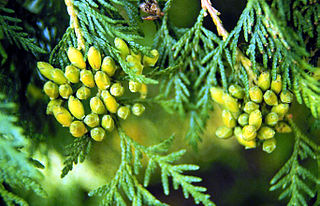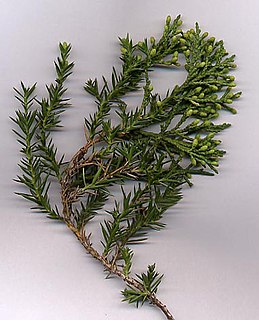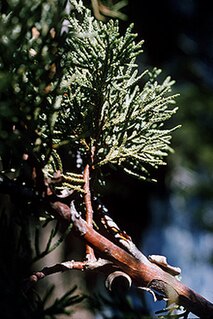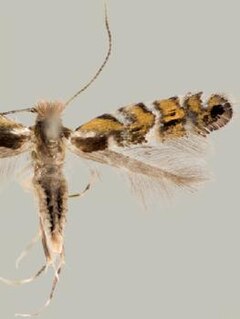| Argyresthia aureoargentella | |
|---|---|
| Scientific classification | |
| Kingdom: | Animalia |
| Phylum: | Arthropoda |
| Class: | Insecta |
| Order: | Lepidoptera |
| Family: | Yponomeutidae |
| Genus: | Argyresthia |
| Species: | A. aureoargentella |
| Binomial name | |
| Argyresthia aureoargentella Brower, 1953 | |
Argyresthia aureoargentella is a moth of the Yponomeutidae family. It is found in North America, including Ontario and Quebec. [1]

Moths comprise a group of insects related to butterflies, belonging to the order Lepidoptera. Most lepidopterans are moths, and there are thought to be approximately 160,000 species of moth, many of which have yet to be described. Most species of moth are nocturnal, but there are also crepuscular and diurnal species.

North America is a continent entirely within the Northern Hemisphere and almost all within the Western Hemisphere; it is also considered by some to be a northern subcontinent of the Americas. It is bordered to the north by the Arctic Ocean, to the east by the Atlantic Ocean, to the west and south by the Pacific Ocean, and to the southeast by South America and the Caribbean Sea.

Ontario is one of the 13 provinces and territories of Canada and is located in east-central Canada. It is Canada's most populous province accounting for 38.3 percent of the country's population, and is the second-largest province in total area. Ontario is fourth-largest in total area when the territories of the Northwest Territories and Nunavut are included. It is home to the nation's capital city, Ottawa, and the nation's most populous city, Toronto, which is also Ontario's provincial capital.
Adults are whitish. They are on wing from early June to late July. There is one generation per year. [2]
The larvae feed on Thuja occidentalis . They mine the leaves of their host plant. Pupation takes place in a whitish, spindle-shaped cocoon that is located outside the mine on the foliage. [3]

Thuja occidentalis, also known as northern white-cedar or eastern arborvitae, is an evergreen coniferous tree, in the cypress family Cupressaceae, which is native to eastern Canada and much of the north, central and upper Northeastern United States, but widely cultivated as an ornamental plant. The species was first described by Carl Linnaeus in 1753, and the binomial name remains current.

A leaf miner is the larva of an insect that lives in and eats the leaf tissue of plants. The vast majority of leaf-mining insects are moths (Lepidoptera), sawflies and flies (Diptera), though some beetles also exhibit this behavior.










